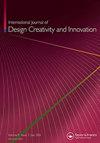基于设计师内在动机的自我驱动设计活动过程分析——以专业平面设计师为例
IF 2.5
Q4 ENGINEERING, MANUFACTURING
International Journal of Design Creativity and Innovation
Pub Date : 2020-05-03
DOI:10.1080/21650349.2020.1755368
引用次数: 0
摘要
内在动机是设计活动中的一个重要因素,因为它在实现创造性设计成果方面发挥着作用。先前的研究表明,即使没有发现客户的问题或需求,设计师也可以自发地发起设计活动。本研究的目的是阐明基于设计师内在动机的自我驱动设计活动的过程特征。在一个针对专业平面设计师的案例研究中,我们将她的自我驱动设计活动过程与旨在解决给定客户问题的客户驱动设计活动进行了比较。我们从两个角度比较了这两个过程:行动顺序和决策策略。在设计过程中,使用基于问题的方法定期收集数据,每周使用回顾性报告方法收集数据。结果表明,自我驱动的设计活动过程是信息收集和构思的迭代,而客户驱动的设计行为过程是行为的线性组合。设计者在没有明确客户问题的情况下开始信息收集,甚至在过程的后期也经常在操作之间切换。结果表明,管理者应该支持资源收集,并允许在流程后期采取灵活的行动,以改进自我驱动的设计活动。本文章由计算机程序翻译,如有差异,请以英文原文为准。
Analysis of process of self-driven design activity based on designer’s intrinsic motivation: case study of a professional graphic designer
ABSTRACT Intrinsic motivation is an important factor in design activity as it plays a role in achieving creative design outcomes. Previous studies suggested that designers can spontaneously initiate design activity even without the identification of a customer problem or need. The purpose of this study was to clarify the characteristics of the process underlying self-driven design activity based on the designer’s intrinsic motivation. In a case study targeting a professional graphic designer, we compared her process of self-driven design activity with that of customer-driven design activity aimed at solving a given customer problem. We compared both processes from two viewpoints: the sequence of actions and the decision-making strategy. During the design process, data were collected regularly using a question-based method and weekly using a retrospective-report method. The results suggest that the self-driven design activity process is an iteration of information gathering and idea sketching, whereas the customer-driven design activity process is a linear combination of actions. The designer starts information gathering without a clear customer problem and frequently switches among actions even late in the process. The results indicate that managers should support resource collection and allow flexibility of action even late in the process to improve self-driven design activity.
求助全文
通过发布文献求助,成功后即可免费获取论文全文。
去求助
来源期刊

International Journal of Design Creativity and Innovation
ENGINEERING, MANUFACTURING-
CiteScore
3.80
自引率
27.80%
发文量
15
期刊介绍:
The International Journal of Design Creativity and Innovation is an international publication that provides a forum for discussing the nature and potential of creativity and innovation in design from both theoretical and practical perspectives. Design creativity and innovation is truly an interdisciplinary academic research field that will interest and stimulate researchers of engineering design, industrial design, architecture, art, and similar areas. The journal aims to not only promote existing research disciplines but also pioneer a new one that lies in the intermediate area between the domains of systems engineering, information technology, computer science, social science, artificial intelligence, cognitive science, psychology, philosophy, linguistics, and related fields. The journal covers, but is not restricted to, the following topics: ·Theories on Design Creativity and Innovation ·Cognition of Design Creativity ·Innovative Process ·Inventive Process ·Analogical Reasoning for Design Creativity and Innovation ·Design Synthesis ·Method and Tools for Design Creativity and Innovation ·Representation of Design Creativity and Innovation ·Education for Design Creativity and Innovation ·Concept Generation and Inspiration.
 求助内容:
求助内容: 应助结果提醒方式:
应助结果提醒方式:


